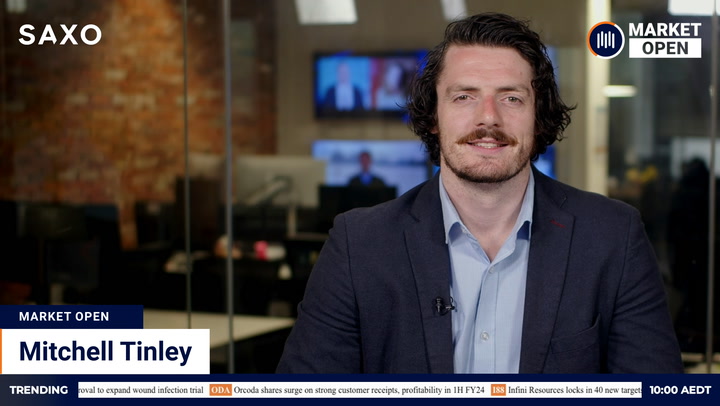The ASX 200 was set to open almost 100 points lower after an accelerating sell-off pushed the S&P 500 below a key level as global growth worries intensified.
ASX futures skidded 99 points or 1.39 per cent, signalling further pressure after two days of heavy losses. The ASX 200 fell 85 points yesterday to extend its decline since Friday to 244 points or 3.3 per cent.
Selling on Wall Street also engulfed commodity markets. Oil suffered its heaviest fall since late March. Iron ore declined almost 5 per cent. Gold, copper and other metals also retreated. The dollar dropped below 70 US cents.
Wall Street
US stocks finished sharply lower after China tightened Covid restrictions in Shanghai and Beijing and a rally in long-term interest rates continued. A strengthening dollar pressured commodity prices.
The S&P 500 slumped 132 points or 32.2 per cent, closing below 4,000 for the first time since March 2021. The decline extended the benchmark’s retreat from its peak to 17 per cent.
The Dow Jones Industrial Average shed 654 points or 1.99 per cent. The Nasdaq Composite swooned 521 points or 4.29 per cent.
Some of Wall Street’s largest companies suffered breath-taking falls. Plane-maker Boeing dived 10.47 per cent. Tesla lost 9.05 per cent. Nvidia 9.24 shed per cent.
The losses came as US treasury yields climbed to their highest since November 2018. Technology and other growth companies fared worst in anticipation of weaker earnings as the cost of borrowing rises.
“Markets are digesting the start of a return to a more normal monetary policy environment,” Kristina Hooper, chief global market strategist at Invesco, said.
Hooper said the Fed’s plan to raise rates aggressively this year to rein inflation “raises the specter of a recession, especially with all of these complications – high inflation, Russia’s invasion of Ukraine, COVID-related supply chain disruptions.”
The global economy appears to be caught in a perfect storm, with western nations raising rates to curb inflation at the same time as Chinese growth wilts under Covid lockdowns. Commodity prices had held up well until recently, supported by the supply hit from the Ukraine war. Sentiment appeared to turn in recent days as Chinese efforts to erase Covid in Shanghai undermined demand. President Xi Jinping last week reiterated his government’s commitment to zero-Covid.
“The Covid-zero policy [in China] has throttled household spending and has not left the productive side of the economy unscathed,” analysts at Morgan Stanley wrote. “The risk of an extended contraction is plain to see.”
Energy, which had been this year’s best-performing sector, tumbled 8.3 per cent overnight. Marathon Oil sank 14.03 per cent, Occidental Petroleum 10.93 per cent, Exxon Mobil 7.89 per cent and Chevron 6.7 per cent.
Australian outlook
A challenging session coming up after the S&P 500 cracked a psychologically-significant support level and moved to within a few percentage points of a bear market. (The Nasdaq has been there for some time.)
“The S&P 500 closed below 4,000 for the first time in 14 months, all sectors were in the red (led by energy) and 85% of its stocks declined. We doubt this bodes well for the ASX 200 today,” Matt Simpson, senior market analyst at City Index, said.
“Since Friday we’ve seen 91.5% and then 80.5% of its stocks tank. We suspect we’ll see a similar figure by today’s close. 7,000 is the next obvious target for bulls to defend, with 7040 making a likely interim support level.”
The ASX has defied gravity for much of this year, thanks to buoyant commodity prices. Some of that support dwindled overnight. Energy stocks appear particularly vulnerable, given the scale of US losses.
Real estate investment trusts were next worst with a loss of 4.62 per cent. The sector has been hit hard by the rising cost of borrowing and its higher risk profile relative to the returns available via bonds.
The US materials sector shed 3.24 per cent, technology 3.94 per cent and financials 2.46 per cent. Consumer staples was the only sector to finish higher – and that was a skinny 0.05 per cent.
The S&P/ASX 200 has strong downward momentum after two days of heavy falls, but may find technical support around the 7000 level. A break below 6980 could bring this year’s low of 6838 into play in the days ahead.
The dollar tumbled to its lowest level since July 2020 as the greenback continued to attract “risk-off” inflows. The Aussie was lately down 1.34 per cent at 69.5 US cents.
Surveys on consumer confidence (weekly) and business confidence (monthly) are scheduled for release this morning. Toll road operator Atlas Arteria holds its AGM.
Commodities
Iron ore crumbled as China toughened Covid restrictions in Shanghai, reversing tentative signs the city was starting to emerge from lockdown. Beijing also imposed new regulations.
“It’s not looking pretty this week with even more negative covid-related headlines for Beijing, Guangdong, and Jilin released over the weekend,” Atilla Widnell, managing director with Navigate Commodities, told Reuters.
“It’s looking increasingly likely that Chinese blast furnaces will struggle to justify high utilization and operating rates in a demand- and margin-negative environment,” Widnell added.
The spot price for ore landed at Tianjin dived US$6.45 or 4.7 per cent to US$131.99 a tonne. The most-traded contract on the Dalian Commodity Exchange fell 7 per cent before trimming its loss to 5.8 per cent.
BHP‘s US-traded depositary receipts slumped 5.63 per cent. The miner’s UK listing shed 4.44 per cent. Rio Tinto coughed up 4.55 per cent in the US and 4.63 per cent in the UK.
Oil unwound recent gains after Saudi Arabia lowered prices in Europe and Asia, and China reported soft export data. Brent crude settled US$6.45 or 5.7 per cent lower at US$105.94 a barrel. The US benchmark shed 6.1 per cent.
Saudi Aramco reduced prices for several of its major export markets. Asian customers saw the biggest cut amid a threat to market share from Russian crude. Chinese trade data yesterday underlined the demand hit from Covid lockdowns.
Industrial metals succumbed to worries about Chinese demand and pressure from a rising US dollar. Benchmark copper on the London Metal Exchange fell 1.8 per cent to US$9,240.40 a tonne. Aluminium sagged 3.2 per cent, nickel 6.3 per cent, lead 3.6 per cent, zinc 4.3 per cent and tin 5.6 per cent.
Gold had its worst session in a week as dollar gains undermined demand for alternative stores of wealth. Metal for June delivery settled US$24.20 or 1.3 per cent weaker at US$1,858.60 an ounce. The NYSE Arca Gold Bugs Index shed 5.81 per cent.
“The [US] dollar is proving the haven asset of choice at a time of continued falls on equity markets in the wake of the Federal Reserve’s trajectory of interest rate hikes and now concerns over China’s economic growth due to the ongoing COVID-related lockdown,” Rupert Rowling, market analyst at Kinesis Money, told MarketWatch.





